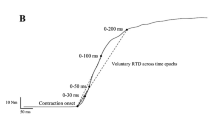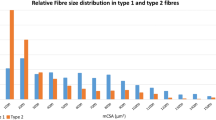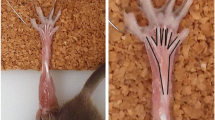Abstract
Idiopathic inflammatory myopathies (IIMs) are autoimmune disorders of skeletal muscle causing weakness and disability. Utilizing single fibre contractility studies, we have previously shown that contractility is affected in muscle fibres from individuals with IIMs. For the current study, we hypothesized that a compensatory increase in shortening velocity occurs in muscle fibres from individuals with IIMs in an effort to maintain power output. We performed in vitro single fibre contractility studies to assess force–velocity relationships and maximum shortening velocity (Vmax) of muscle fibres from individuals with IIMs (25 type I and 58 type IIA) and healthy controls (66 type I and 27 type IIA) and calculated maximum power output (Wmax) for each fibre. We found significantly higher Vmax (mean ± SEM) of fibres from individuals with IIMs, for both type I (1.40 ± 0.31 fibre lengths/s, n = vs. 0.63 ± 0.13 fibre lengths/s; p = 0.0019) and type IIA fibres (2.00 ± 0.17 fibre lengths/s vs 0.77 ± 0.10 fibre lengths/s; p < 0.0001). Furthermore, Wmax (mean ± SEM) was maintained compared to fibres from healthy controls, again for both type I and type IIA fibres (4.10 ± 1.00 kN/m2·fibre lengths/s vs. 2.00 ± 0.16 kN/m2·fibre lengths/s; p = ns and 9.00 ± 0.64 kN/m2·fibre lengths/s vs. 6.00 ± 0.67 kN/m2·fibre lengths/s; p = ns respectively). In addition, type I muscle fibres from individuals with IIMs was able to develop maximum power output at lower relative force. The findings of this study suggest that compensatory responses to maintain power output, including increased maximum shortening velocity and improved efficiency, may occur in muscle of individuals with IIMs. The mechanism underlying this response is unclear, and different hypotheses are discussed.







Similar content being viewed by others
Data availability
The datasets generated during and/or analysed during the current study are available from the corresponding author on reasonable request.
References
Askanas V, Engel WK, Nogalska A (2015) Sporadic inclusion-body myositis: a degenerative muscle disease associated with aging, impaired muscle protein homeostasis and abnormal mitophagy. Biochim Biophys Acta 1852(4):633–643. https://doi.org/10.1016/j.bbadis.2014.09.005
Benveniste O, Stenzel W, Hilton-Jones D, Sandri M, Boyer O, van Engelen BG (2015) Amyloid deposits and inflammatory infiltrates in sporadic inclusion body myositis: the inflammatory egg comes before the degenerative chicken. Acta Neuropathol 129(5):611–624. https://doi.org/10.1007/s00401-015-1384-5
Bottinelli R, Reggiani C (1995) Force–velocity properties and myosin light chain isoform composition of an identified type of skinned fibres from rat skeletal muscle. Pflugers Arch 429(4):592–594
Bottinelli R, Reggiani C (2000) Human skeletal muscle fibres: molecular and functional diversity. Prog Biophys Mol Biol 73(2–4):195–262
Bottinelli R, Betto R, Schiaffino S, Reggiani C (1994) Unloaded shortening velocity and myosin heavy chain and alkali light chain isoform composition in rat skeletal muscle fibres. J Physiol 478(Pt 2):341–349
Bottinelli R, Canepari M, Pellegrino MA, Reggiani C (1996) Force–velocity properties of human skeletal muscle fibres: myosin heavy chain isoform and temperature dependence. J Physiol 495(Pt 2):573–586
Brenner B (1983) Technique for stabilizing the striation pattern in maximally calcium-activated skinned rabbit psoas fibers. Biophys J 41(1):99–102. https://doi.org/10.1016/s0006-3495(83)84411-7
Coirault CL, Lambert F, Pourny J-C, Lecarpentier Y (2002) Velocity of actomyosin sliding in vitro is reduced in dystrophic mouse diaphragm. Am J Respir Crit Care Med 165(2):250–253. https://doi.org/10.1164/ajrccm.165.2.2105088
Coley W, Rayavarapu S, Pandey GS, Sabina RL, Van der Meulen JH, Ampong B, Wortmann RL, Rawat R, Nagaraju K (2012) The molecular basis of skeletal muscle weakness in a mouse model of inflammatory myopathy. Arthritis Rheumatol 64(11):3750–3759.
Cooke R, Bialek W (1979) Contraction of glycerinated muscle fibers as a function of the ATP concentration. Biophys J 28(2):241–258. https://doi.org/10.1016/S0006-3495(79)85174-7
Cooke R, Pate E (1985) The effects of ADP and phosphate on the contraction of muscle fibers. Biophys J 48(5):789–798. https://doi.org/10.1016/S0006-3495(85)83837-6
Dalakas MC, Hohlfeld R (2003) Polymyositis and dermatomyositis. Lancet 362(9388):971–982. https://doi.org/10.1016/S0140-6736(03)14368-1
D’Antona G, Pellegrino MA, Adami R, Rossi R, Carlizzi CN, Canepari M, Saltin B, Bottinelli R (2003) The effect of ageing and immobilization on structure and function of human skeletal muscle fibres. J Physiol 552(Pt 2):499–511. https://doi.org/10.1113/jphysiol.2003.046276
Dubowitz V, Oldfors A, Sewry CA (2013) Muscle biopsy: a practical approach. Elsevier Health Sciences, Philadelphia
Dweck D, Reyes-Alfonso A Jr, Potter JD (2005) Expanding the range of free calcium regulation in biological solutions. Anal Biochem 347(2):303–315. https://doi.org/10.1016/j.ab.2005.09.025
Edman KA (1979) The velocity of unloaded shortening and its relation to sarcomere length and isometric force in vertebrate muscle fibres. J Physiol 291:143–159
Fabiato A, Fabiato F (1979) Calculator programs for computing the composition of the solutions containing multiple metals and ligands used for experiments in skinned muscle cells. J Physiol (Paris) 75(5):463–505
Fink RH, Stephenson DG, Williams DA (1990) Physiological properties of skinned fibres from normal and dystrophic (Duchenne) human muscle activated by Ca2+ and Sr2+. J Physiol 420:337–353
Gilliver SF, Degens H, Rittweger J, Sargeant AJ, Jones DA (2009) Variation in the determinants of power of chemically skinned human muscle fibres. Exp Physiol 94(10):1070–1078. https://doi.org/10.1113/expphysiol.2009.048314
Godt RE, Maughan DW (1977) Swelling of skinned muscle fibers of the frog. Experimental observations. Biophys J 19(2):103–116. https://doi.org/10.1016/s0006-3495(77)85573-2
Granzier HL, Irving TC (1995) Passive tension in cardiac muscle: contribution of collagen, titin, microtubules, and intermediate filaments. Biophys J 68(3):1027–1044. https://doi.org/10.1016/s0006-3495(95)80278-x
Harrison BC, Allen DL, Leinwand LA (2011) IIb or not IIb? Regulation of myosin heavy chain gene expression in mice and men. Skelet Muscle 1:5
Henning F, Kohn TA (2020) An exploratory study of contractile force production in muscle fibers from patients with inflammatory myopathies. Muscle Nerve 62(2):284–288. https://doi.org/10.1002/mus.26904
Hill AV (1938) The heat of shortening and the dynamic constants of muscle. Proc R Soc Lond B 126(843):136–195. https://doi.org/10.1098/rspb.1938.0050
Himori K, Ashida Y, Tatebayashi D, Abe M, Saito Y, Chikenji T, Westerblad H, Andersson DC, Yamada T (2021) Eccentric resistance training ameliorates muscle weakness in a mouse model of idiopathic inflammatory myopathies. Arthritis Rheumatol 73(5):848–857. https://doi.org/10.1002/art.41594
Horowits R (1999) The physiological role of titin in striated muscle. Rev Physiol Biochem Pharmacol 138:57–96. https://doi.org/10.1007/BFb0119624
Kluger BM, Krupp LB, Enoka RM (2013) Fatigue and fatigability in neurologic illnesses: proposal for a unified taxonomy. Neurology 80(4):409–416. https://doi.org/10.1212/WNL.0b013e31827f07be
Kohn TA, Myburgh KH (2006) Electrophoretic separation of human skeletal muscle myosin heavy chain isoforms: the importance of reducing agents. J Physiol Sci 56(5):355–360. https://doi.org/10.2170/physiolsci.RP007706
Kohn TA, Noakes TD (2013) Lion (Panthera leo) and caracal (Caracal caracal) type IIx single muscle fibre force and power exceed that of trained humans. J Exp Biol 216(Pt 6):960–969. https://doi.org/10.1242/jeb.078485
Krivickas LS, Ansved T, Suh D, Frontera WR (2000) Contractile properties of single muscle fibers in myotonic dystrophy. Muscle Nerve 23(4):529–537. https://doi.org/10.1002/(SICI)1097-4598(200004)23:4%3c529::AID-MUS11%3e3.0.CO;2-Y
Krivickas LS, Yang JI, Kim SK, Frontera WR (2002) Skeletal muscle fiber function and rate of disease progression in amyotrophic lateral sclerosis. Muscle Nerve 26(5):636–643. https://doi.org/10.1002/mus.10257
Krivickas LS, Amato AA, Krishnan G, Murray AV, Frontera WR (2005) Preservation of in vitro muscle fiber function in dermatomyositis and inclusion body myositis: a single fiber study. Neuromuscul Disord 15(5):349–354. https://doi.org/10.1016/j.nmd.2005.01.011
Larsson L, Moss RL (1993) Maximum velocity of shortening in relation to myosin isoform composition in single fibres from human skeletal muscles. J Physiol 472:595–614
Larsson L, Li X, Frontera WR (1997) Effects of aging on shortening velocity and myosin isoform composition in single human skeletal muscle cells. Am J Physiol 272(2 Pt 1):C638-649. https://doi.org/10.1152/ajpcell.1997.272.2.C638
Lassche S, Stienen GJ, Irving TC, van der Maarel SM, Voermans NC, Padberg GW, Granzier H, van Engelen BG, Ottenheijm CA (2013) Sarcomeric dysfunction contributes to muscle weakness in facioscapulohumeral muscular dystrophy. Neurology 80:733–737
Liang C, Needham M (2011) Necrotizing autoimmune myopathy. Curr Opin Rheumatol 23(6):612–619. https://doi.org/10.1097/BOR.0b013e32834b324b
Magid A, Law DJ (1985) Myofibrils bear most of the resting tension in frog skeletal muscle. Science 230(4731):1280–1282
Malisoux L, Francaux M, Nielens H, Theisen D (2006) Stretch-shortening cycle exercises: an effective training paradigm to enhance power output of human single muscle fibers. J Appl Physiol (1985) 100(3):771–779. https://doi.org/10.1152/japplphysiol.01027.2005
Malisoux L, Jamart C, Delplace K, Nielens H, Francaux M, Theisen D (2007) Effect of long-term muscle paralysis on human single fiber mechanics. J Appl Physiol (1985) 102(1):340–349. https://doi.org/10.1152/japplphysiol.00609.2006
Maruyama K, Natori R, Nonomura Y (1976) New elastic protein from muscle. Nature 262(5563):58–60. https://doi.org/10.1038/262058a0
Mastaglia FL, Garlepp MJ, Phillips BA, Zilko PJ (2003) Inflammatory myopathies: clinical, diagnostic and therapeutic aspects. Muscle Nerve 27(4):407–425. https://doi.org/10.1002/mus.10313
Miller AE, MacDougall JD, Tarnopolsky MA, Sale DG (1993) Gender differences in strength and muscle fiber characteristics. Eur J Appl Physiol Occup Physiol 66(3):254–262
Needham M, James I, Corbett A, Day T, Christiansen F, Phillips B, Mastaglia FL (2008) Sporadic inclusion body myositis: phenotypic variability and influence of HLA-DR3 in a cohort of 57 Australian cases. J Neurol Neurosurg Psychiatry 79(9):1056–1060. https://doi.org/10.1136/jnnp.2007.138891
Persechini A, Stull JT, Cooke R (1985) The effect of myosin phosphorylation on the contractile properties of skinned rabbit skeletal muscle fibers. J Biol Chem 260(13):7951–7954
Powers K, Joumaa V, Jinha A, Moo EK, Smith IC, Nishikawa K, Herzog W (2017) Titin force enhancement following active stretch of skinned skeletal muscle fibres. J Exp Biol 220(Pt 17):3110–3118. https://doi.org/10.1242/jeb.153502
Prosser CL (1973) Comparative animal physiology. W.B. Saunders, Philadelphia
Seow CY, Ford LE (1997) Exchange of ATP for ADP on high-force cross-bridges of skinned rabbit muscle fibers. Biophys J 72(6):2719–2735. https://doi.org/10.1016/S0006-3495(97)78915-X
Sweeney HL, Kushmerick MJ (1985) Myosin phosphorylation in permeabilized rabbit psoas fibers. Am J Physiol 249(3 Pt 1):C362-365. https://doi.org/10.1152/ajpcell.1985.249.3.C362
Talmadge RJ, Roy RR (1993) Electrophoretic separation of rat skeletal muscle myosin heavy-chain isoforms. J Appl Physiol (1985) 75(5):2337–2340. https://doi.org/10.1152/jappl.1993.75.5.2337
Trappe S, Gallagher P, Harber M, Carrithers J, Fluckey J, Trappe T (2003) Single muscle fibre contractile properties in young and old men and women. J Physiol 552(Pt 1):47–58. https://doi.org/10.1113/jphysiol.2003.044966
Wagner S, Knipp S, Weber C, Hein S, Schinkel S, Walther A, Bekeredjian R, Müller OJ, Friedrich O (2012) The heart in Duchenne muscular dystrophy: early detection of contractile performance alteration. J Cell Mol Med 16(12):3028–3036. https://doi.org/10.1111/j.1582-4934.2012.01630.x
Wang K, McClure J, Tu A (1979) Titin: major myofibrillar components of striated muscle. Proc Natl Acad Sci USA 76(8):3698–3702. https://doi.org/10.1073/pnas.76.8.3698
Warshaw DM (1996) The in vitro motility assay: a window into the myosin molecular motor. Physiology 11(1):1–7. https://doi.org/10.1152/physiologyonline.1996.11.1.1
Widrick JJ, Trappe SW, Blaser CA, Costill DL, Fitts RH (1996a) Isometric force and maximal shortening velocity of single muscle fibers from elite master runners. Am J Physiol 271(2 Pt 1):C666-675
Widrick JJ, Trappe SW, Costill DL, Fitts RH (1996b) Force–velocity and force–power properties of single muscle fibers from elite master runners and sedentary men. Am J Physiol 271(2 Pt 1):C676-683
Widrick JJ, Knuth ST, Norenberg KM, Romatowski JG, Bain JL, Riley DA, Karhanek M, Trappe SW, Trappe TA, Costill DL, Fitts RH (1999) Effect of a 17 day spaceflight on contractile properties of human soleus muscle fibres. J Physiol 516(Pt 3):915–930
Yamashita-Goto K, Okuyama R, Honda M, Kawasaki K, Fujita K, Yamada T, Nonaka I, Ohira Y, Yoshioka T (2001) Maximal and submaximal forces of slow fibers in human soleus after bed rest. J Appl Physiol (1985) 91(1):417–424. https://doi.org/10.1152/jappl.2001.91.1.417
Author information
Authors and Affiliations
Contributions
The experimental work was performed in the MyoLab of Professor Kohn, Division of Exercise Science and Sports Medicine, University of Cape Town. FH and TAK conceptualised and designed the study. FH performed the acquisition, analysis, and interpretation of the data, and drafted and revised the manuscript. TAK revised the manuscript. All authors approved the final version and takes full accountability for the accuracy of the manuscript content. All listed authors qualify for authorship.
Corresponding author
Ethics declarations
Conflict of interest
All authors confirm no competing interests or conflicting interests.
Additional information
Publisher's Note
Springer Nature remains neutral with regard to jurisdictional claims in published maps and institutional affiliations.
Supplementary Information
Below is the link to the electronic supplementary material.
10974_2022_9638_MOESM1_ESM.tiff
Supplementary file1 (TIFF 3197 kb) Supplementary Fig. 1 Force–length traces of a type IIA muscle fibre from a healthy control. After attaining maximum force, the lever motor was controlled by the software to shorten the length of the fibre (right axis) to yield a predetermined percentage of absolute maximum force isotonically (force clamp, left axis). For this fibre, the series of force clamps corresponded to 80%, 55%, 30% and 10% of absolute maximum force, each lasting 150 ms. For each fibre, the shortening velocity was determined from the last 50 ms of each force clamp (length change), from which the slope was plotted against the force (% of maximum). After the last force clamp, the fibre was briefly shortened for 2 ms to 50% of its initial length, and rapidly re-stretched back to its original length. Three force clamp series followed, each series consisting of different percentages of maximum force. Once all the series were completed, the fibre was returned to the relaxing solution. P0 = maximum force
10974_2022_9638_MOESM2_ESM.tiff
Supplementary file2 (TIFF 3019 kb) Supplementary Fig. 2 Example of a sodium dodecyl sulphate-polyacrylamide gel electrophoresis (SDS-PAGE) separation of myosin heavy chain (MyHC) isoforms. MyHC isoforms were identified using a homogenate that contained all three human MyHC isoforms as control
Rights and permissions
Springer Nature or its licensor (e.g. a society or other partner) holds exclusive rights to this article under a publishing agreement with the author(s) or other rightsholder(s); author self-archiving of the accepted manuscript version of this article is solely governed by the terms of such publishing agreement and applicable law.
About this article
Cite this article
Henning, F., Kohn, T.A. Preservation of shortening velocity and power output in single muscle fibres from patients with idiopathic inflammatory myopathies. J Muscle Res Cell Motil 44, 1–10 (2023). https://doi.org/10.1007/s10974-022-09638-w
Received:
Accepted:
Published:
Issue Date:
DOI: https://doi.org/10.1007/s10974-022-09638-w




